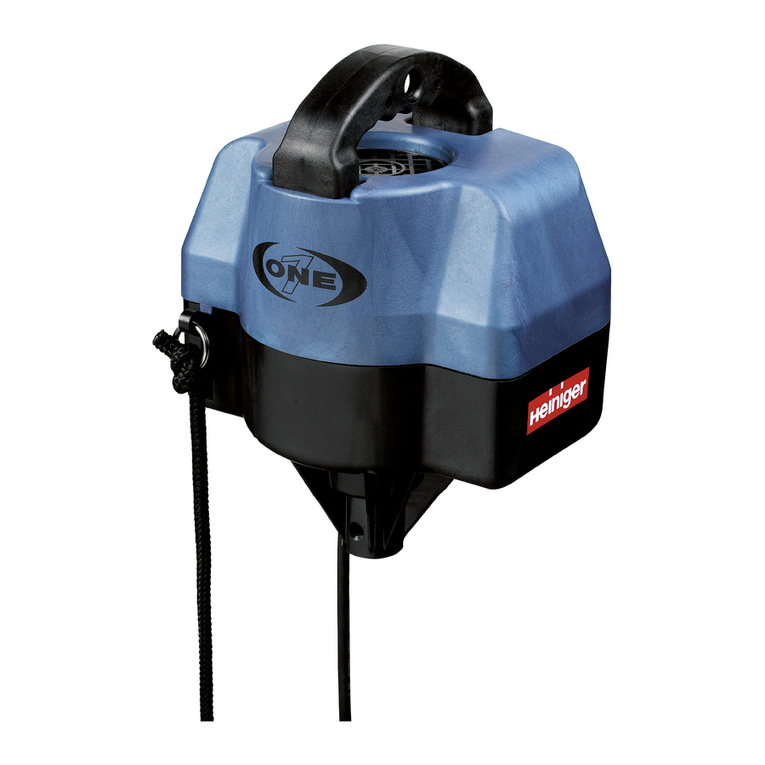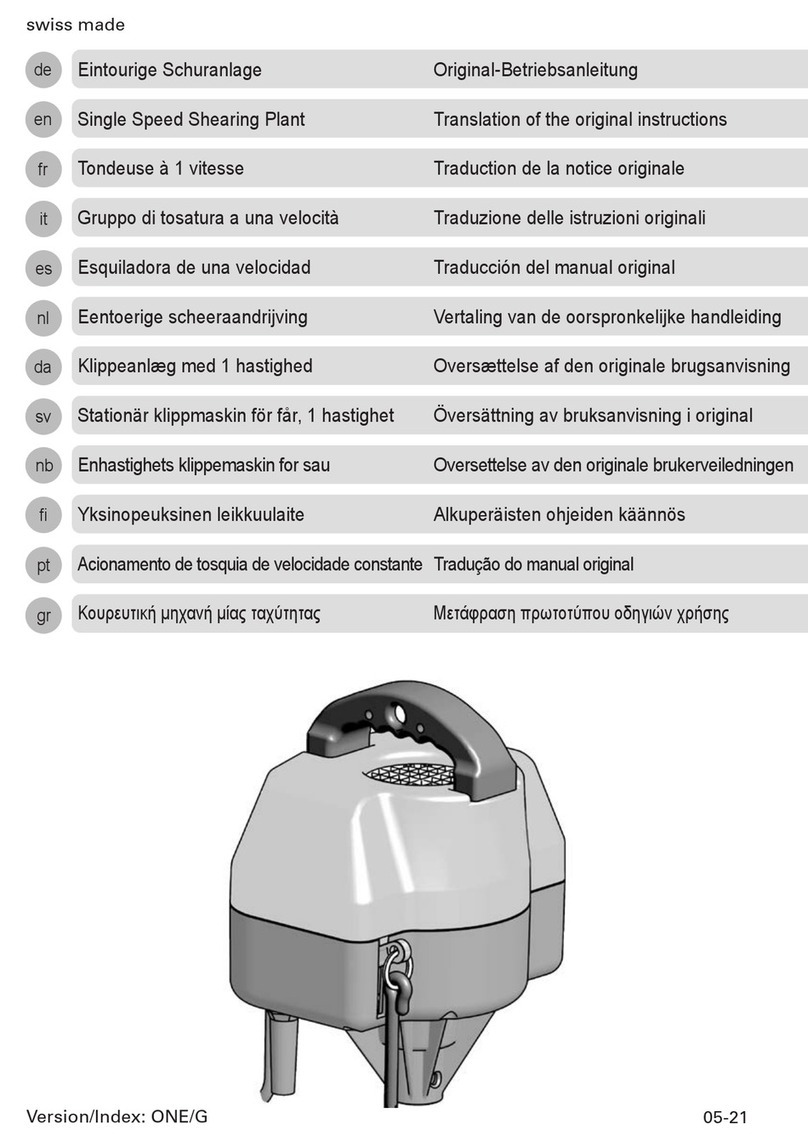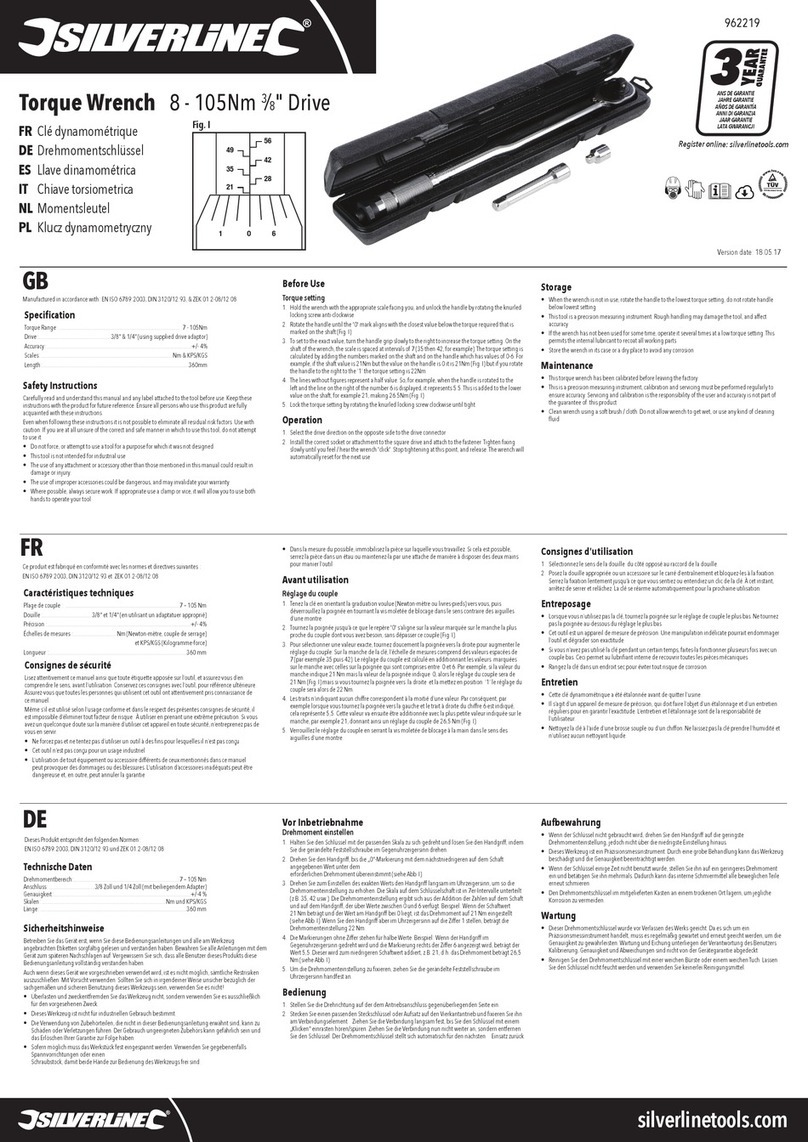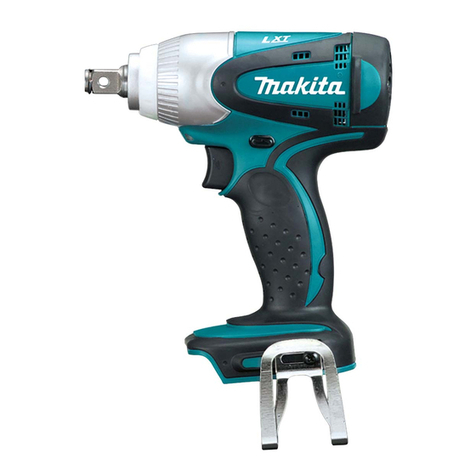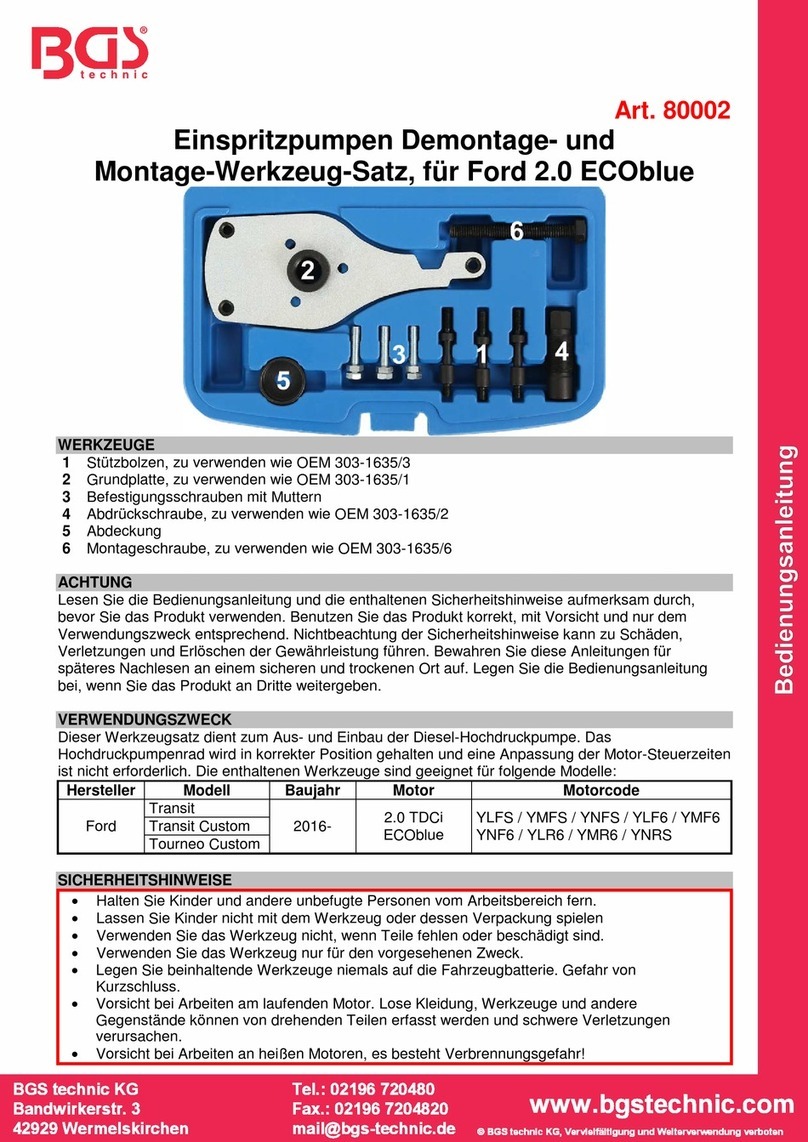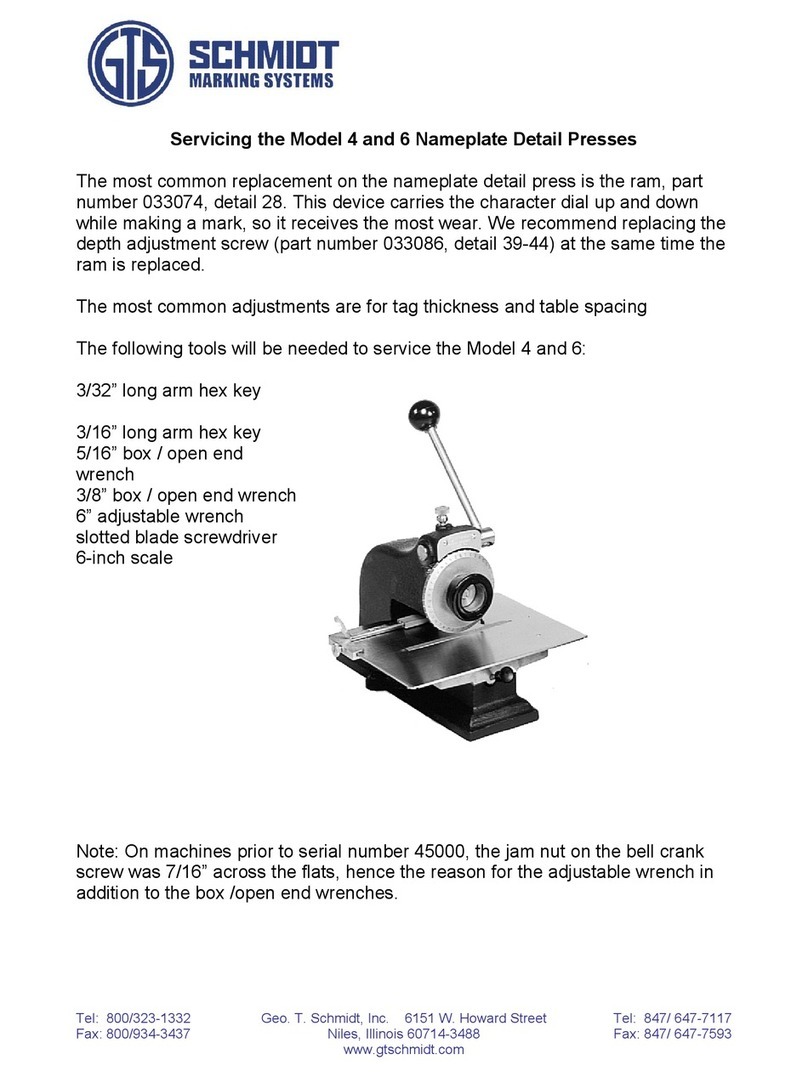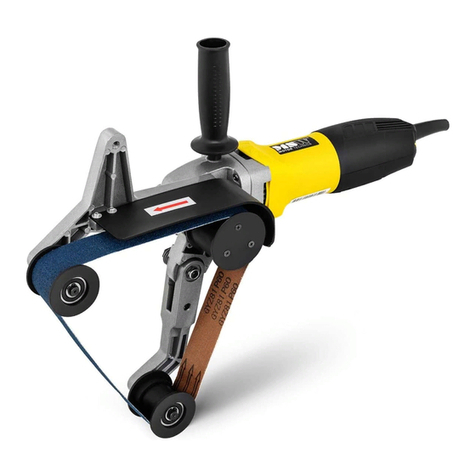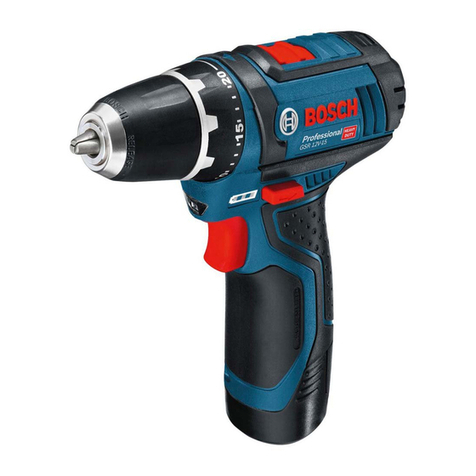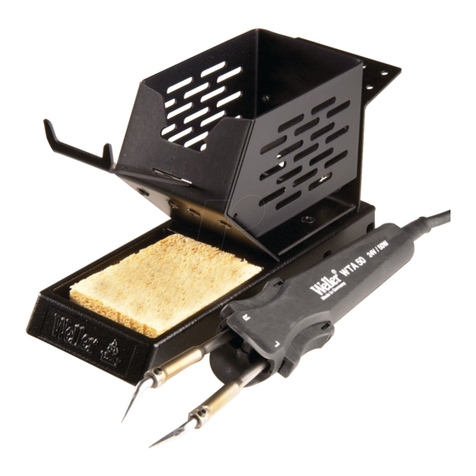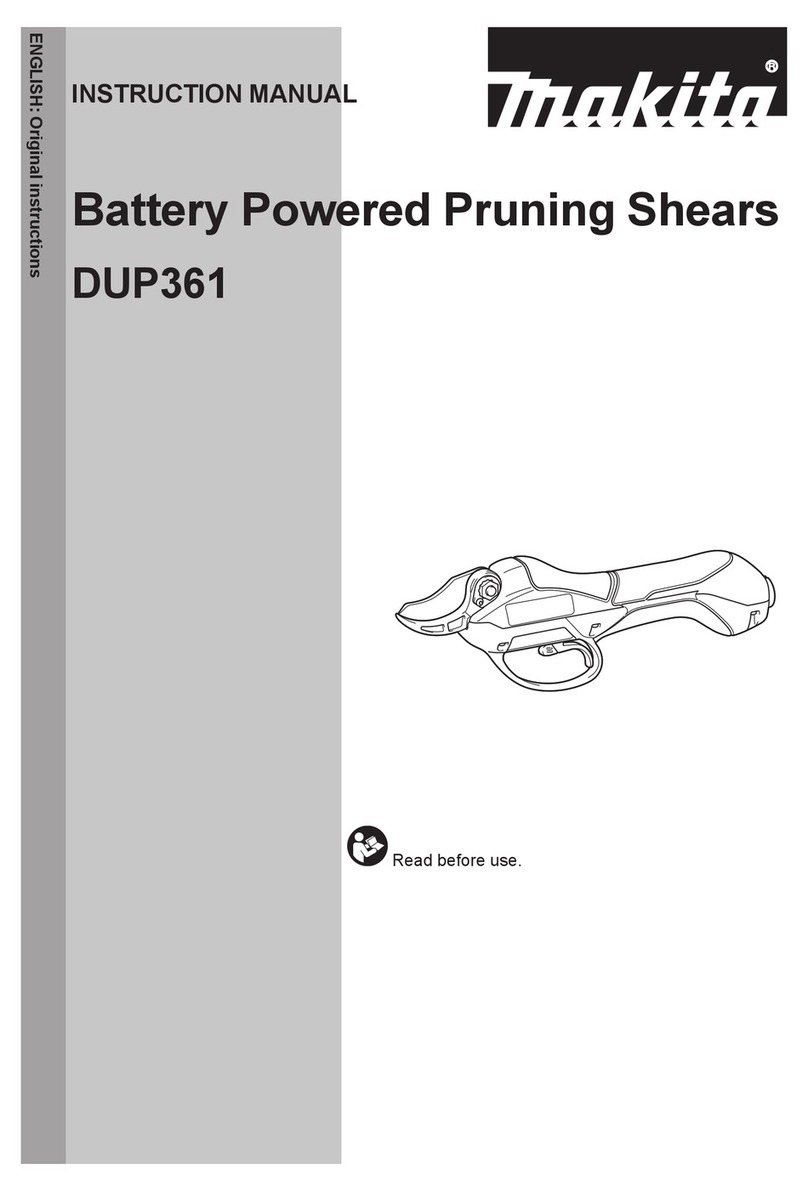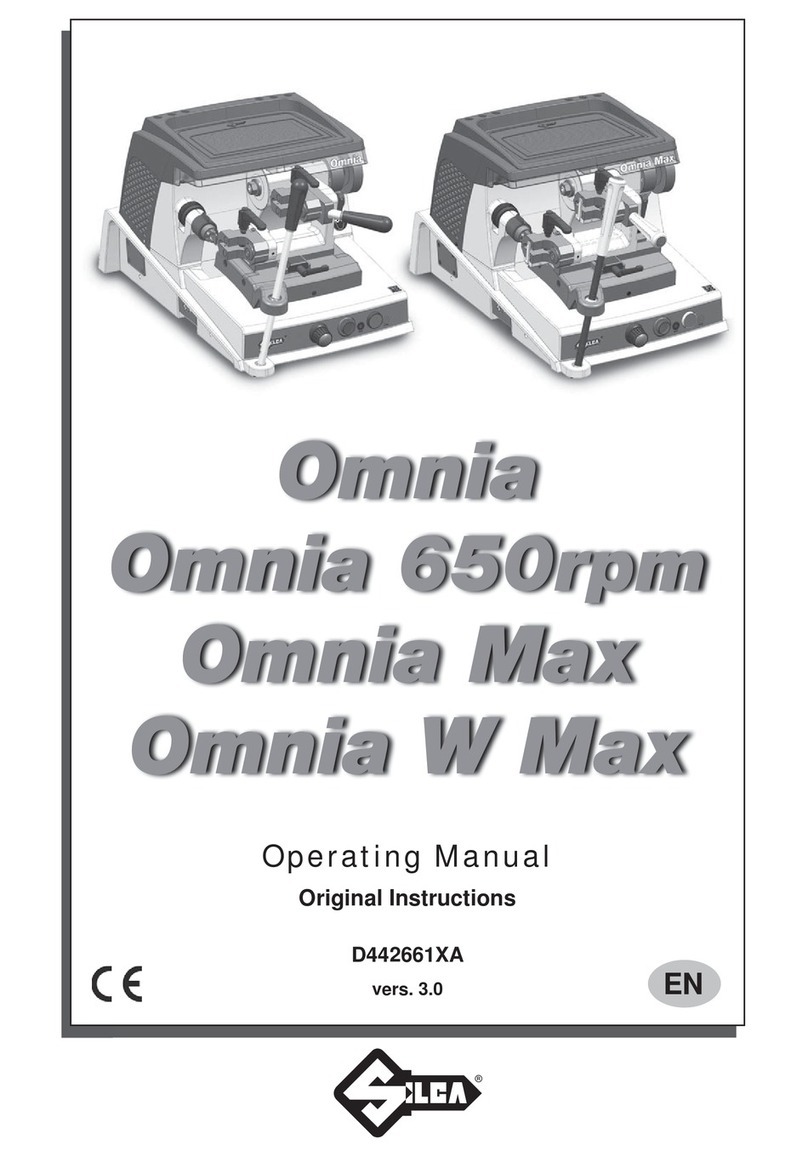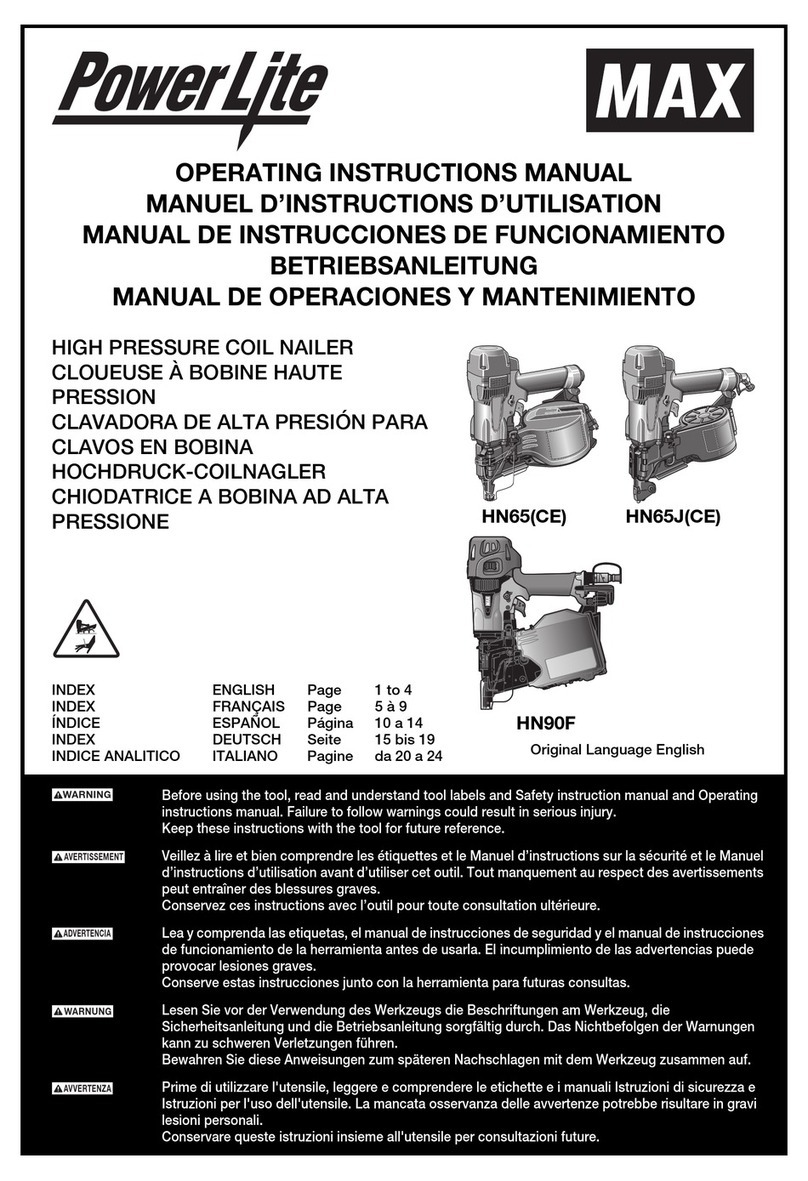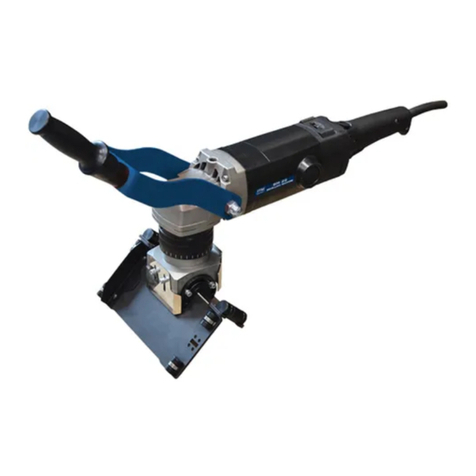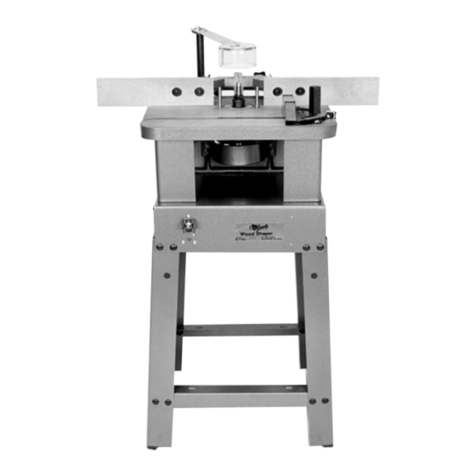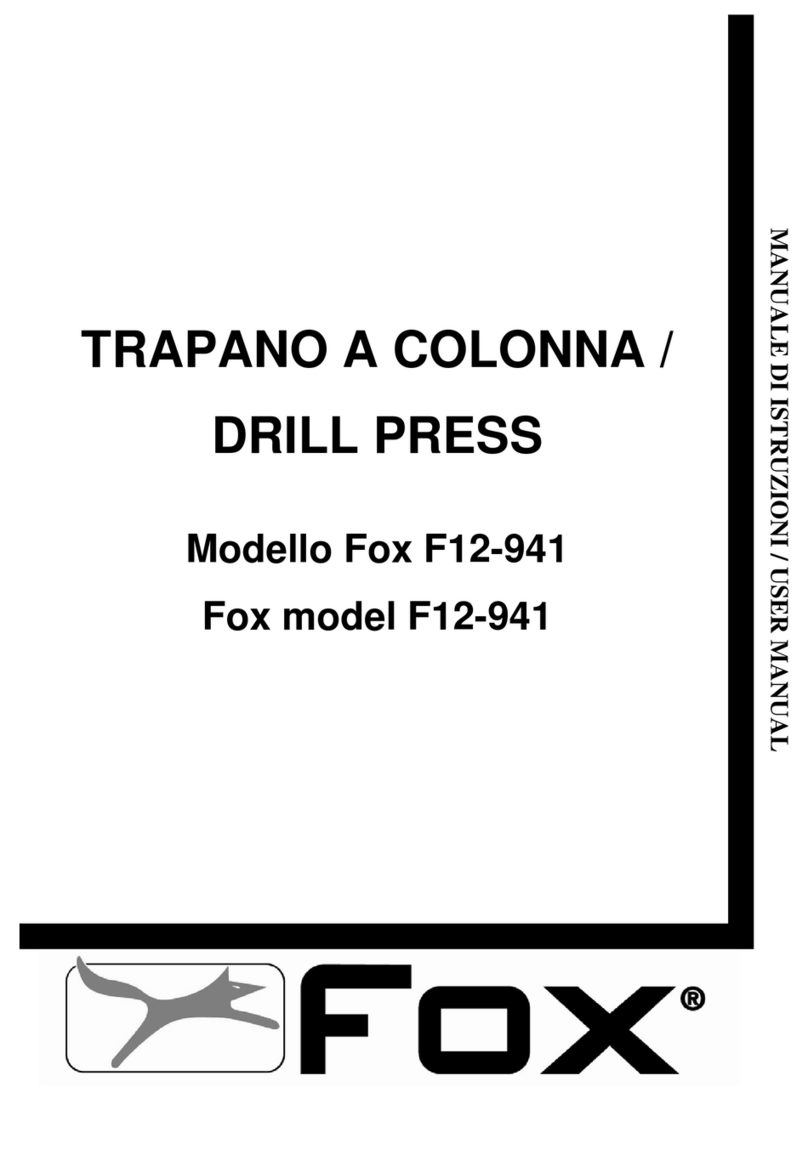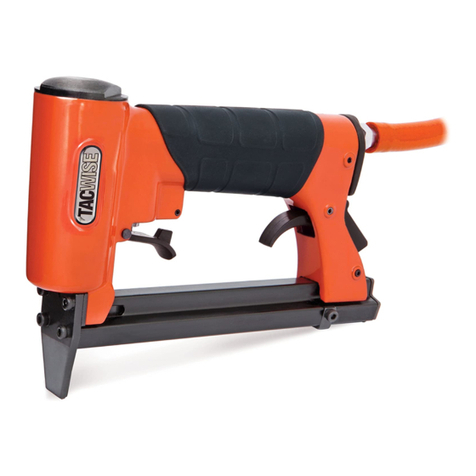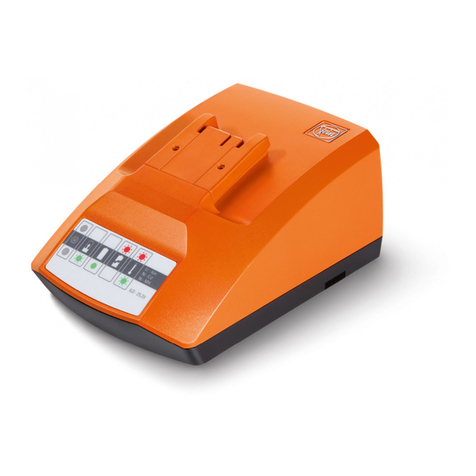Heiniger TPW Aussie Xpress User manual

T
TP
PW
W
W
WO
OO
OL
LP
PR
RE
ES
SS
S
Operator manual
for models
Aussie Xpress
&
Kiwi Xpress
Read before operating
Manufactured by
HEINIGER AUSTRALIA

MA005 TPW Woolpress Operator Manual 2019-06-06
Rev:05
2
Contents
1General information
1.1 Introduction
1.2 Intended use
1.3 Contact addresses
2Safety
2.1 Safety notice
2.2 Essential operator skills
2.3 Measures for avoiding accidents
3Accepting delivery
4Transporting
5Guarantee
5.1 Introduction
5.2 Guarantee period
5.3 Conditions
6Technical data
6.1 Dimensions
6.2 Electric
6.3 Petrol
6.4 Hydraulic system
6.5 Cycle time
6.6 Weighing system
7Power supply & connections
8Assembly
9Jockey wheel
10 Woolpress operation
11 Weighing system
11.1 Scale operation
11.2 Weighing modes
11.3 System care
11.4 Span calibration procedure
11.5 Avoid overweight bales
11.6 Mechanical considerations
12 Woolpress maintenance
12.1 Safety guard maintenance
12.2 General maintenance
12.3 Daily maintenance
12.4 Monthly maintenance
12.5 Oil change
12.6 Filter change
12.7 Pressure relief valve
12.8 Control valve neutral adjustment
12.9 Baling pin adjustment
12.10 Unpinning clearance
12.11 Hydraulic pump operation
12.12 Pump adjustment procedure
13 Troubleshooting
14 General layout illustration
15 Side view
16 Lubrication points illustration
17 Warranty registration

MA005 TPW Woolpress Operator Manual 2019-06-06
Rev:05
3
1General information
1.1 Introduction
This manual has been compiled to assist in the operation and maintenance of TPW
Woolpresses.
HEINIGER Australia reserves the right to amend, add or delete any parts of these
instructions of specification without notice.
Note: As it is not possible to instruct a person to a competent level in the use of this
woolpress from a manual alone, HEINIGER Australia asserts that the owner/manager of this
woolpress must employ an operator who will be familiar with wool pressing in general and
has an understanding of the process and some terminology or else will be instructed and/or
supervised by a person with these requisites. Regardless of this the person operating this
press must be able to read and understand this manual
If this is not the case then no attempt should be made to use this press.
1.2 Intended use.
The TPW Woolpress is designed, manufactured and supplied for pressing wool. Other uses
are expressly prohibited
The details in 6Technical data, count as mandatory operating limits and ratings.
1.3 Contact addresses
HEINIGER Australia
5A Tayet Link
Bibra Lake, Western Australia 6163
T: +61 8 9434 0000
F: +61 8 9434 0011
E: mail@heiniger.com.au
W: www.heiniger.com.au
HEINIGER New Zealand
1B Chinook Place
Hornby Christchurch
T: +64 3 349 8282
F: +64 3 349 8292
E: mail@heiniger.co.nz
W www.heiniger.com
HEINIGER Australia
5 Devon Street
Lonsdale, SA 5163
T: +61 8 8326 0890
2Safety
2.1 Safety Notice
HEINIGER Australia has fitted this woolpress with safety devices to help protect the operator
during use. Should these safety devices become inoperable for any reason, it is the
responsibility of the owner to ensure it is repaired before further use. All defects should be
reported immediately to your supervisor.
It is an offence to operate this woolpress without the safety device fitted and in proper
working order.
2.2 Essential operator skills
The owner/manager of this woolpress has an obligation to ensure that the operator is
competent to use the press.
Operating the press safely only makes small demands of the operator. It is essential that
they are observed and carried out.
The operator must have read and understood the manual or have been instructed in the
operation of the press by a skilled person and have had the potential dangers pointed out to
him. The operator shall be able to demonstrate an understanding of the press controls and
the hazards associated with the press.
The continued effectiveness of the safety device shall be tested by the operator prior to the
start of each shift of pressing, and at any time the operator has reason to suspect failure of
any safety device component.
It is an offence to operate the press without the safety device fitted in proper working order.

MA005 TPW Woolpress Operator Manual 2019-06-06
Rev:05
4
2.3 Measures for avoiding accidents.
➢Do not reach into any part of the woolpress while it is operating
➢Store the woolpress in a dry undercover area when not in use
➢Avoid getting electrical components of the woolpress wet
➢Hang the power cable from the roof to avoid a tripping hazard and to avoid damaging
the cord. Ensure the cord will not get caught in moving parts at the top of the
woolpress
➢After use disconnect the power
➢Switch the woolpress off before disconnecting the power
➢Never leave the woolpress unsupervised when connected to the power
➢Avoid kinks and tight coils in the cable when storing, this can damage the cable
➢The operating instructions must be kept safely and accessible to the operator at all
times
➢Do not wear loose clothing or jewellery when using this woolpress, tie back long hair
➢The safe guards fitted to this woolpress must be kept in proper condition
➢The safe guards must be fitted and operational before using this woolpress
➢Children are not permitted to use the woolpress
➢Children are not permitted in the vicinity of the woolpress when it is being operated or
maintenance is being carried out
➢Never use a damaged woolpress. Have the woolpress repaired by an authorized service
agent or qualified technician
➢Any damage to or failure of the woolpress which may constitute a risk to the health and
safety of any person shall be immediately reported by the operator to the
owner/manager who shall take appropriate action
Examples of the type of damage which would constitute such a risk include:
➢Damage to any part of the woolpress
➢Frayed or damage insulation on electrical wiring;
➢Cracked, perished or damaged hydraulic hoses, pipes or fittings;
➢Overheating of any motor or pump; or
➢Failure or wear of any control or component.
➢Damaged or loose fasteners, nuts, bolts, etc.

MA005 TPW Woolpress Operator Manual 2019-06-06
Rev:05
5
3Accepting delivery
All units are transported at the owner's risk.
Before accepting delivery, thoroughly inspect the Woolpress for damage.
If any has occurred you should note the nature and extent of the damage in view of any
insurance claim you may wish to make.
Whilst all care is taken during manufacture and by our agents to ensure your woolpress
arrives in perfect working order and condition, damage occurring during transit or faulty
operation resulting from damage occurring during transit will not be covered by our
warranty.
The following areas should be checked carefully:
➢Guide rods, including the return bolt and the adjustable pinning lug, these must be
present and secure.
➢The pinning guards. They should locate securely in place.
➢Check scale components, indicator, cords and fittings.
➢Electrical components etc (where fitted).
➢Petrol Engine (when fitted).
➢All ancillary equipment, i.e. panels, axles, wheels, jockey wheel, etc
➢Hydraulics, Check for leakage at all connections and damage to hoses etc.
➢Check fluid levels.
➢Check that safety devices are operating correctly.
➢Electric motor (where fitted) Fan cover etc.
4Transporting.
The TPW Woolpress is supplied on transport skids. It is advisable to use the transport skids
whenever practicable when transporting the woolpress.
Ensure that there is no load on the load cell or wheels and the hydraulic cylinder is lowered.
A Woolpress Trolley is available, to enable easy movement from shed to shed. The trolley
should only be used when it is safe to do so.
When moving the press with the transport skids fitted it is advisable to:
➢Use only a forklift truck that is adequate for the task.
➢Use only a driver qualified to operate the forklift truck.
➢Only move over a stable, level surface.
➢Lift only from the bottom of the woolpress between the transport skids and the base of
the press.
➢Lift only from the front or rear of the woolpress.
➢Spread the forks as wide as possible within this space.
➢Ensure that the woolpress is fully on the forks before lifting.
➢Keep the woolpress as close to the ground as possible when moving.
➢Move no faster than walking pace.
➢Take care when turning corners and stopping as the woolpress may slide on the forks.
➢Lower the woolpress gently.
➢Only lower the woolpress onto a stable, level surface.
Because of the woolpresses height and centre of gravity when the hydraulic cylinder is in its
operating position it can be unstable when being moved, for this reason it is advisable to
fold the cylinder down when transporting.
Even when the cylinder is folded down care needs to be taken when transporting.
When the press is delivered from the factory the cylinder will be in the folded down position.

MA005 TPW Woolpress Operator Manual 2019-06-06
Rev:05
6
5Guarantee
5.1 Introduction
HEINIGER Australia guarantee the 'TPW Woolpress" manufactured by them to be free from
defect in workmanship and materials. Their obligations pursuant to this guarantee are
limited to the repair or replacement of parts and workmanship which prove defective within
the specified period.
The repair or replacement shall be affected upon the defective equipment being returned
freight pre-paid to the registered office of HEINIGER Australia or New Zealand or when
authorised to the authorised Service Agents.
All travelling costs incurred by Service Agents performing repairs under warranty will be the
owner’s responsibility.
Where HEINIGER Australia supplies goods not manufactured by HEINIGER Australia, the
customer shall only be entitled to such benefits as HEINIGER Australia may receive under
guarantee as given to HEINIGER Australia by the manufacturer of those goods.
Some parts not covered by HEINIGER Australia
Hydraulic Cylinder, Hydraulic hoses, Electric motor, Hydraulic pump assembly, Hydraulic
control valve, Starter switch, Scale components.
(These parts generally have to be sent back to the manufacturer for warranty inspection
and assessment)
5.2 Guarantee period on parts manufactured by HEINIGER Australia
Primary producers: 25 months from the date of delivery.
Contractors: 12 months from the date of delivery.
5.3 Conditions
This guarantee will be invalidated for any of the following reasons:
1. If notice of the defect is not given to HEINIGER Australia or New Zealand within the
guarantee period.
2. If the woolpress has been subject to misuse, abuse, negligence or accident.
3. If the woolpress is installed, maintained or operated in any manner other than that for
which it is designed.
4. If the woolpress is used for any duty or subjected to any abnormal operating conditions
varying from that for which it is supplied by HEINIGER Australia.
When making a warranty claim or ordering new parts, it is important that the serial number
of the unit is quoted and the date of purchase stated.
6Technical data
6.1 Dimensions
Height operational: 2705mm
Height shipping: 1970mm
Box height: 1185mm
Length: 1390mm
Width: 970mm
Weight: 530kg
6.2 Electric
Motor: Teco Induction
Electric: 4kw (5.5hp), 415V, 3Ø, 1440rpm
Electric: 2.2kw (3hp), 240V or 480V at 1460rpm
Electrical operating voltage and current:
Nominal Min Volts Return stroke Full load
Volts Full load Current Current
240 V 220 V 11.0A 16.0A
480 V 440 V 6.0A 8.0A
415 V 8.0A 8.0A

MA005 TPW Woolpress Operator Manual 2019-06-06
Rev:05
7
6.3 Petrol
Engine: Honda 11 hp, Rope or Electric start.
Battery not supplied.
Remote power pack.
6.4 Hydraulic system
Oil capacity: 25 Litres
Oil type: Mobil DTE 24 or equivalent
Oil filter: Inline suction, 25 micron
Pump: Nachi PVS-IB-22 Variable displacement piston pump.
Discharge at 1460 rpm: 30 L/min @ 0-5 Mpa, and 7L/min @ 5-18 Mpa.
Control valve: Oilpath OP20 2000
Cylinder: G&R 88.9mm bore by 740mm stroke.
Pressure relief: 18,000kpa (2600psi)
6.5 Cycle time Empty Full bale
With 240 V or 480 V: 12 seconds 16 seconds
With 220 V or 440 V: 13 seconds 20 seconds (low power supply)
6.6 Weighing system
Make: Iconix FX1
Indication: LCD
Power supply: 12V DC
Load sensing: Single load cell
Zero facility: Automatic zero tracking or by zero facility.
Calibration: Factory calibrated
Memory: Will retain last shown weight indefinitely.
Range 1.0 kg -750kg.
Specifications subject to change without notice.
Designed to comply with current Occupational Safety and Health regulations.
6.7 IP Rating
Product
IP Rating
Information
Contact
5.5kw cast frame TECO Motor
IP 56
TECO NZ
Mohammad TECO
Technician Auckland
2.2kw cast frame TECO Motor
IP 44
TECO NZ
Mohammad TECO
Technician Auckland
SS Switch + button
IP 65
NAW
Luke Sales Tech Melbourne
DOL Switch + button
IP 65
NAW
Luke Sales Tech Melbourne

MA005 TPW Woolpress Operator Manual 2019-06-06
Rev:05
8
7Power supply & connections.
It is the responsibility of the owner to ensure correct power supply.
➢The voltage specified on the electric motor manufacturers plate and that of the local
power supply must match. The press motor may only be connected to an AC power
supply.
➢In the event that the press is operated from a generator, the mains supply voltage
must not exceed that specified on the manufacturer’s plate.
➢Never plug the press into damaged sockets.
➢Observe the relevant regulations applicable in your country.
➢Completely unroll the power cable before plugging in.
➢If a 3 phase motor is fitted the rotation must be checked prior to using the press.
Correct rotation direction is indicated on the pump.
Note: Damage to woolpress components caused by incorrect power supply will not be
covered by warranty.
8Assembly
Note: Before assembling the woolpress ensure that there is adequate headroom for the
woolpress. (see 6 Technical data)
Note: DO NOT cycle the woolpress with an empty wool pack in the chamber, damage to
the press and pack will occur.
Warning: Always ensure the control valve handle is in the neutral (centre) position before
starting the motor.
For assembly of the woolpress, the following procedures must be carried out:
1. Note the IMPORTANT sticker on the press, which emphasises the need for the owners
and operators to read the operators manual and to complete and return the warranty
card.
2. Check the level of hydraulic oil (100mm from the top +/- 25mm) and crankcase oil
level on petrol driven models.
3. Check the correct voltage is being supplied e.g. 240 volt or 480 volt. If 3 phase check
motor rotation. If incorrect an electrician should reverse. If an extension lead must be
used, it must be a 20 amp lead. Avoid leads longer than 10m.
4. Cut the cable ties that fasten the platen to the support bars, remove the nuts and
washers from the cylinder mounting bolts.
5. With the control valve handle in the neutral or centre position, start the motor.
6. If the starter switch chatters and will not engage during start up, suspect low voltage
power supply. An electrician should check the supply voltage under starting load and
full load.
Warning: When using the hydraulics to raise the cylinder as described here, the motion of
the cylinder does not appear consistent with the action of the handle, ie, when you pull the
handle down the cylinder moves up. It is important to be aware of how the press will react
to the movement of controls.
Warning: There is a pinch hazard between the flange plate of the cylinder and the top
cross members of the press. Keep hands and fingers clear of the cylinder flange while
raising the cylinder.
Warning: When raising the platen for the first time ensure that the top of the right hand
guide rod does not get caught under the cylinder hydraulic hoses. If the guiderod is too
close to the hoses, stop the platen and pull the hoses out of the way. The hoses must be
restrained so that at no time can they get caught on the guide rod. If the guide rod does
get caught on the hoses significant damage will occur to the woolpress. This damage will
not be covered by warranty.
7. To extend the cylinder upward towards the crossbeam, ease the control valve handle
down. Rotate the cylinder casing if necessary to align it with the mounting bolts. Keep
hands clear of cylinder flange while raising the cylinder.
8. Stop the motor.
9. Fit the washers and nuts to the mounting bolts to finger tight only.

MA005 TPW Woolpress Operator Manual 2019-06-06
Rev:05
9
10. Start the motor and ease the control valve handle up to raise the platen until the
unpinning post pins are level with the tips of the pawls when the pawls are held with
the tip at its lowest possible point (see illus at 12.10). Stop the motor.
Warning: Do not attempt to hold any part of the press components (accept for the control
valve handle) when raising the cylinder or platen.
11. Ensure that the gap between the tip of the pawl and the unpinning post pin is even on
both sides. (see illus at 12.10)
12. Tighten the mounting bolts & nuts securely. Remove the support bars from the press.
13. Fit the load cell foot and remove the transport feet.
14. Adjust the load cell foot so the press is level. Tighten the load cell foot lock nut against
the load cell.
15. Secure the jockey wheel in its catch and check to ensure that the jockey wheel brake
foot is clear of the floor.
16. Fit the indicator onto its bracket and plug the load cell lead into the indicator.
17. With the press closed, plug the power supply in, then switch on using the ON/ZERO
key. The display should indicate zero, ▲. If not press ON/ZERO. Applying weight to
the press structure should register a reading.
18. Before operating the wool press, lubricate all moving parts. When the bellcranks and
baling pins are lubricated fit the pinning guards. (see illus)
19. Start the woolpress and cycle it a few times to expel any air, which may be trapped in
the hydraulic system.
9Jockey Wheel
To use the Jockey Wheel pull it free of the catch and lower it towards the floor, this
transfers the weight of the woolpress from the loadcell foot to the Jockey Wheel.
The woolpress is now ready to move.
To use the brake foot lift the Jockey Wheel handle up about half way, retain a firm grip on
the handle, when the brake foot contacts the ground it will stop the woolpress.
When the woolpress has come to a complete stop lift the Jockey Wheel up and push the
plastic knob firmly into the catch to secure it.
Note: When pressing wool ensure that the Jockey Wheel is secured in the catch and the
loadcell foot is fitted to the correct height so the brake foot on the Jockey Wheel is clear of
the floor.
When moving the woolpress the loadcell foot must be clear of the floor.
When using the Jockey Wheel do not release it until it has been secured in the catch. If
released, unrestrained upward movement can cause damage to the woolpress.
Do not allow any part of your body to come between the Jockey Wheel and the woolpress.
When moving the woolpress it is important that it has come to a complete stop before
lowering the weight of the woolpress onto the loadcell foot.
The woolpress should not be used or moved on uneven, unstable or sloping surfaces.
10 Jockey wheel illustration

MA005 TPW Woolpress Operator Manual 2019-06-06
Rev:05
10
Woolpress operation.
1. Close the rear door of the woolpress and secure with the locking bar handle.
2. Make sure the control valve handle is in the neutral position. Switch the press on.
3. With the hungry board and pack lock handle in the closed position turn the scales on
and check that they are reading zero before proceeding.
4. Lift the pack lock handle and the hungry board. Hang the bale ejector belt over the
front, centre of the bin and place the hook into the hook pocket, make sure that the
pins in the packlock handle will not pierce the strap. The doubled over stitched part of
the strap should be level with the bottom of the packlock when it is closed. Place a
pack in the woolpress. Hang the flaps of the pack neatly over the four sides of the
woolpress. The corner stitching should come to the top of the box. Close the hungry
board firmly and secure with the pack lock handle.
5. Ensure that the hook on the hungry board is fitted over the locking bar handle,
preventing the locking bar and door from being opened when the hungry board is
closed.
6. Secure the pack lock handle with the pack lock clamp.
7. Fill the chamber to its maximum with wool. Pull the guard down. This will allow you to
pull the control valve handle into the down position. The control valve handle will not
operate down with the guard up. Then pull the control valve handle into the down
position.
8. On the first pressing only, allow the platen to come down until just before the pins
come in, push the control valve handle to the up position to return the platen to the
top of it's stroke. If needed lift the guard.
9. After the first pressing, load more wool pull the control valve handle down and allow
the press to complete its cycle without interruption. When the platen is returning it will
automatically lift the guard.
Note: If the pressing chamber of the press is not full of wool when the press is cycled the
pack may get pushed into the chamber by the baling pins. If this happens it is possible for
damage to occur to the pack and press.
Note: Always allow the press to complete a cycle. If a cycle is interrupted when the press
is next cycled damage may occur due to the press being out of sequence.
Warning: When the press commences a cycle all parts of the operators body must be
clear of the pressing chamber.
10. During the pressing cycle the operator can get more wool. Continue compressing the
wool until the desired weight has been achieved. HEINIGER recommends 190 -195 Kg
11. Closing off pack. On achieving desired bale weight allow the press to finish the cycle,
while the pins are still in, spread wool evenly by pulling it from the centre of the bale
and placing it to the sides of the press, cycle the press again to re-pin.
12. Open the pack lock clamp and pack lock handle and lift the hungry board, fold the left
flap over the right flap and secure firmly with 3 bale fasteners, then fold the back flap
over the front flap and secure with 4 bale fasteners. (The firmer the flaps -the neater
the bale.)
13. Bale ejection. Close the hungry board and pack lock clamp. Pull the guard down. Pull
the control valve handle down; as the platen descends, the bale pins will automatically
withdraw. Allow the platen to continue downwards until the yellow mark on the right
hand guide rod lines up with the yellow line on the cylinder.
14. Push the control valve handle into the middle/neutral position to stop platen
movement.
15. Lift up the guard and open the pack lock and hungry board.
16. Attach the bale ejector belt hook to the bale ejector catch. Then open the back door.
17. Push the control valve handle up to raise the platen, thus completing the operation
and ejecting the bale through the rear door.
See warnings & notes.

MA005 TPW Woolpress Operator Manual 2019-06-06
Rev:05
11
Warning: Do not attempt to eject a bale without first opening the door, substantial
damage to the press will occur otherwise.
18. Disconnect the bale ejector belt from the bale ejector catch. The platen may have to
be lowered slightly to do this. Ensure that the bale ejector belt is placed over the front
of the pressing chamber.
19. Close the rear door of the woolpress and secure with the locking handle.
Note: Ejection from the rear of the press is possible by attaching the bale ejector belt
from the front, move to the rear of the press with a woolbale trolley. Send the hydraulic
ram upwards by pulling down on the yellow handle on the rear of the control valve
linkage, thereby ejecting the bale onto the trolley. Take care not to over balance and get
caught under the ejecting bale and trolley.
Note: If the bale ejector belt is not placed over the front of the pressing chamber prior to
pressing a bale, the bale will have to be unpinned and the wool removed by hand.
Note: If the guard is lifted during operation it will cause the platen to ascend.
The press will not operate in its down cycle with the guard raised or the hungry board
open.
Ensure that the ejection catch is stowed on top of the platen when not in use.
11 Weighing system
11.1 Scale operation
1. Plug the power supply and the load cell into the indicator.
2. Press the ON/ZERO key. The scale will automatically show zero unless weight has
been left on the scale. The ZERO pointer ▲will show that the scale is at zero.
3. If the scale does not show zero, press ON/ZERO.
11.2 Weighing modes
Free mode: Normal weighing mode for woolpresses, Free mode is automatically selected
at switch on. The display is continuously updated with the weight currently on the scale.
Hold mode: A press of the WEIGH key switches the scale to hold mode, which is suitable
for live animal weighing. Hold mode uses an averaging process, which displays the
accurate weight of a moving animal. The weight is locked on the display until the next key
press. To turn the scale back to Free mode press the ON/ZERO key.
11.3 System care
Fit caps to indicator sockets when not in use to protect from dirt and moisture. Hang the
cable ends up out of mud and dust.
Damage may occur if the capacity of the scale is exceeded.
All cables must be kept in good condition.
11.4 Span calibration procedure
Note: The span calibration is performed independently for each scale type.
Note: To ensure that scale accuracy is maintained, the bale used to calibrate the scales
should be as close to the maximum bale weight as possible.
Note: Start with the indicator turned off.
1. Plug the power supply and load cell into the indicator. Remove all live loads from the
press.
2. Hold the WEIGH key down, then press and release the ON/ZERO key, releasing the
WEIGH key when SEt appears.
3. With no weight on the press, zero the scales with the ON/ZERO key.
Note: In step 4. and 5. once ON/ZERO and WEIGH have been pressed simultaneously, if
you do not start weight adjustment within 5 sec then the shown weight will be saved.
4. Re-press a bale of wool of which the exact weight is known. Allow to settle, then press
and release ON/ZERO and WEIGH simultaneously. The display will show SPAn while
weighing the bale, then display to the nearest kilogram, according to the present
calibration. Eg. 0195.
5. Change the displayed weight to the correct weight using ON/ZERO to increase weight
and WEIGH to decrease weight. One press of a key will increase or decrease the

MA005 TPW Woolpress Operator Manual 2019-06-06
Rev:05
12
weight by 1 kg. For large adjustments to the displayed weight hold down the required
key.
6. When the displayed reading is the same as the bale weight, press no keys for 5
seconds. SAVE is displayed as the new calibration is stored in EEPROM.
7. Remove the bale from the press, the scales should return to zero.
Note: Having completed the span procedure the scales should be switched off then on and
checked to confirm accuracy.
11.5 Avoid Overweight Bales.
Heiniger recommends that bale weights are checked for accuracy by using another set of
scales, which are known to be accurate.
The woolpress must be used on a stable, level surface. Any movement in the floor will
affect the performance of the scales.
Keep obstructions free of the press, make sure there is no build up of wool around or
under the press.
Do not move the press halfway through a bale as the zero reference may not be the same.
Ensure scale is on zero each time before putting the pack in.
If you press the ON/ZERO key when you already have the pack in, make sure you allow
2kg for the weight of the pack.
Bale weights.
Because of weight gains due to dampness or humidity, it is suggested to press bales only
to 190/195kg so that bales do not exceed 204kg.
11.6 Mechanical considerations.
The following are the requirements, which are necessary for the electronic scales to
perform as they are intended. These points can be causes of weighing problems. The zero
facility is provided to reset the zero although this should not normally be necessary.
➢A firm, level floor surface is required
➢Do not move the press around the floor during a bale as this will upset the zero
reference point. If moving is necessary, wait until that bale is completed.
➢Begin and end the bales with the press in the same condition i.e. if the scale is on zero
and the press is ready to operate, (Door and hungry board closed, platen up etc.), the
scale will not zero until the press is in the same condition.
➢Check that there is not a build up of wool around the base of the press as this will
restrict free movement.
➢Check that the two bolts mounting the load cell are tight.
➢Check that the press is level and lock nut on the load cell foot is tight.
➢During operation the jockey wheel must be secured by the catch. The jockey wheel
brake foot must be clear of the floor. If not it will effect the scale operation causing
bale weights to be inaccurate.
➢When moving the woolpress it is important that it has come to a complete stop before
lowering the weight of the woolpress onto the loadcell foot, otherwise damage may
occur to the loadcell and foot.

MA005 TPW Woolpress Operator Manual 2019-06-06
Rev:05
13
12 Woolpress maintenance
12.1 Safety guard maintenance
The press is fitted with an interlocked safety device and guards to protect the operator
during use. These must be maintained for safe/correct operation.
Before each shift starts the following parts must be checked for correct operation.
Safety guard
Valve handle
Safety guard arms
Hungry board interlock assembly
Safety guard linkage
Gas lifting strut
Pinning guards
Valve linkage
These parts are integral to the safe operating of the press. If they become damaged, worn
or loose they must be repaired or replaced before using the press.
When replacing parts use only genuine replacements or parts that have the same
specification.
The following checks must be carried out:
Note: Turn the power off and leave it off while checking the operation of the safety device.
1. With the safety guard open ensure that the valve handle cannot be pulled into the
down position. If it can, repair or adjust before using the press.
2. Close the safety guard, pull the valve handle into the down position. Slowly lift the
guard open. The valve handle should be knocked into neutral or the up position within
approximately 25mm (1”) of upward movement of the safety guard. If it does not,
repair or adjust before using the press.
3. Open the hungry board, close the pack lock and the safety guard. Attempt to pull the
valve handle into the down position. The valve handle should not be able to move into
the down position. If it can, repair or adjust before using the press.
4. Check the security of the pinning guards, the pinning guards are routinely removed for
maintenance. They must be replaced securely before the press is used.
12.2 General maintenance
Ensure the motor is switched off and the power disconnected while performing
maintenance.
Always contact an authorized service centre if you are unsure how to rectify problems and
in the event of a malfunction not contained in this manual.
Maintenance instructions listed here are guide lines only, because of differing conditions
that presses experience it is impossible to say what maintenance a press will need and
when.
Note: If any parts are replaced on the press, use genuine replacement parts or ensure
that replacement parts have the same specification as the old parts.
12.3 Daily maintenance. (8 to 10 hrs of operation)
➢Grease/oil the locking bar, rotate and lift the locking bar for better access. Use a good
quality general purpose grease and good quality engine oil.
➢Check correct operation and adjustment of safety device.
➢Check the security of the platen retaining bolt that secures the platen to the cylinder
rod.
Note: If the press is allowed to operate with this bolt not properly secured the hydraulic
circuit will be placed under undue stress that will prematurely wear components.
12.4 Monthly maintenance. (200 hrs of operation)
➢Grease both guiderods and grease/oil all moving parts.
➢Check the accuracy of the scales. Check the weight of the most recently pressed bale
on scales known to be accurate.
➢Check the security of the cylinder retaining nuts and platen retaining bolt.
➢Check the security of all other fasteners. Some fasteners secure hinging parts, do not
over tighten these fasteners. Hinging parts need to move freely through the range of
movement without being loose.
➢Check the hydraulic oil level and replenish as necessary. Use specified oil.

MA005 TPW Woolpress Operator Manual 2019-06-06
Rev:05
14
➢The hydraulic oil level is checked with the platen in the up position. To check, remove
the filler/breather cap on the tank. The oil should be approximately 100mm from the
top +/- 25mm.
➢Oil the bellcrank assembly and baling pin bosses, remove the pinning guard to do so.
Apply oil to all moving joints, wipe off excess. The bellcranks can be moved in and out
by hand.
➢Check the security of the circlips retaining all pins.
➢Check the adjustment of the baling pins.
➢Clear any wool from inside the pinning guards.
Note: Failure to perform reasonable maintenance on the press will result in premature
wear or damage to the press. This wear or damage is not covered by the manufacturer’s
warranty.
12.5 Oil change
Change the oil every 12000 hours of operation. This is an approximate figure. If the oil is
contaminated by water or foreign matter, or has been overheated then the oil will need
changing more frequently.
12.6 Filter change
Change the oil filter and tank filler/breather cap every 2000 hours of operation. This is an
approximate figure. If the press is operating in a very dusty or humid environment the
filters will need changing more frequently.
Note: If any parts are replaced on the press, use genuine replacement parts or ensure
that replacement parts have the same specification as the old parts.
12.7 Pressure relief valve
Situated on the control valve (see illustration). The pressure in this valve is factory set to
18,000 KpA(2600 psi) and should NOT be adjusted. Occasionally, this valve may be heard
to squeal when the press has returned to neutral. This is caused by the spool not
centralising, either through the detent on the bottom of the spool becoming loose, or the
valve trip lever not operating correctly.
Control valve illustration
Spool
Top of
cylinder
Return
Bottom of
cylinder
Dome nut
Relief
Detent cover
Spring
tensioner
Lock nut
Spring
Valve
needle
Detent
Spring
Valve
OILPATH
IN
R

MA005 TPW Woolpress Operator Manual 2019-06-06
Rev:05
15
12.8 Control valve neutral adjustment
Due to normal running in of new components it is sometimes necessary to adjust the
control valve neutral rod, to ensure that the control valve will automatically return to
neutral at the completion of its cycle.
Adjustment
Should the valve not drop into neutral, tap the control valve neutral rod to the right or left
until correct action is achieved. Several cycles of the press may be required for this setting.
If the adjustment is moved too far to the left (rear view), or too close to the pivot bolt, the
valve may push too far and go over 'centre' and cause the ram to re-cycle automatically.
This adjustment may require setting from time to time as the press settles in.
Control valve neutral adjustment illustration
12.9 Baling pin adjustment
When the guide rods are at the maximum down position, the pins are correctly set if there
is approximately 1mm of backlash.
To set the Baling pins:
Note: If the left hand bank of pins has less backlash than the right hand it is advisable to
back off (wind up) the adjustment bolt on the top of the left hand guide rod before
proceeding.
1. Send the platen on the down stroke and allow the pins to go in. Carefully watch for
the point when the control valve lever is about to be actuated into the up position and
stop the lever in the "natural" neutral position, with your hand held above the control
lever.
2. Check the backlash between the bellcranks and the bin, and if incorrect, adjust the
return bolt on top of the right hand guide rod carefully ½ a turn at a time, (up to
decrease clearance or down to increase clearance).
3. Repeat the cycle until the correct backlash is achieved.
4. Tighten locknut securely.
5. After setting right bank of pins, repeat procedure for left hand bank of pins using
adjustment bolt on left hand guide rod. Ensure the hexagonal sides of the bolt are
kept parallel with the side of the guide rod when adjustment is complete.
Note: Take care to adjust small amounts then cycle the press each time to prevent over-
adjustment and possible damage to guide rods.
Control valve neutral rod
L/H
R/H
Rocker arm
Rear ejection handle
Viewfrom rear of press
Pinning adjustment
Return bolt
1mm Clearance
Bellcrank
adjustment
Pinning Bin
Platen
Trip Lever

MA005 TPW Woolpress Operator Manual 2019-06-06
Rev:05
16
12.10 Unpinning clearance
The retraction of the baling pins is a crucial part of the press's operation. The pins are
retracted by the unpinning posts, which are welded to the platen, pulling down on the
rocker arm pawls, which are in between the top cross members.
To enable the baling pins to be fully retracted from the wool, the posts must remain in
contact with the pawls until the baling pins are fully retracted.
This length of contact or "travelling purchase" can only be achieved by having the gap
between both components as close as possible once they have separated.
No less than 0mm and no more than 2mm.
If this gap is too excessive due to wear on the pawls or distortion of the platen, the
unpinning posts will lose contact with the pawls prematurely, leaving the baling pins
partially in the bin while the wool is being pressed, possibly resulting in damage to the press
or woolpack.
Unpinning clearance illustration
12.11 Hydraulic pump operation
The Nachi PVS-IB-22 Pump is a variable displacement piston pump with a pressure
compensator valve.
The pump produces a flow of 30 lts/min (7 gpm) until pressure builds to 5000 KpA (750
psi).
This opens the pressure compensator valve and reduces the flow to approximately 7-
9Its/min (1.5-2.0 gpm, second stage)
When the changeover to the second stage happens, you should notice a change in sound
and speed, and a reduction in load on the motor.
The compensator valve adjustment controls the pressure at which the changeover cycle
takes place. 5000 kpa (750psi)
Before adjusting any settings it is advisable to measure and note the standout
distance of the screw. Screw adjustments in to increase, out to decrease.
Cylinder Rod
Rocker arm
post
Unpinning
rod
Push
Platen
Pawl
Guide rod
0mm
+ 2mm
-0mm
clearance

MA005 TPW Woolpress Operator Manual 2019-06-06
Rev:05
17
12.12 Pump adjustment procedure
1. Low pressure adjustment screw (compensator valve). This controls the pump
changeover from 1st to 2nd stage. (Approximately 140 to 150 kilos of wool), It also governs
how fast the platen returns. Voltage drop may be experienced in some sheds. This may
cause the motor to labour around the changeover stage or on the return stroke. A small
adjustment of the Low Pressure screw will cure both problems in most cases.
2. High pressure adjustment lock nuts (minimum stop) the positioning of this setting
determines the flow once the press is in the second stage.
Adjustments of the lock nuts clockwise will increase the flow rate but also increases the
power demand.
Anti clockwise will decrease the flow rate.
This adjustment is only needed if the press is stalling or labouring in the second stage but
rarely has to be reset and should be done with a flow meter and tong tester.
Hydraulic pump adjustment illustration
High pressure
adjustment
nuts
Spring group with
dust cover removed
Lock nut
Low pressure
(for changing to second stage)
adustment screw

MA005 TPW Woolpress Operator Manual 2019-06-06
Rev:05
18
13 Troubleshooting All items marked * see adjustment procedure
Note: For all electrical faults qualified persons only may undertake fault finding & repairs.
Note: For all hydraulic faults qualified persons only should undertake fault finding & repairs.
Problem
Possible cause
Action
The motor will not
Fuses blown
Check reason and replace.
start
Faulty plug
Replace
Start capacitor is
burnt out
Replace
Supply voltage is too low
Correct supply
Starter switch chatters
Supply voltage is too low
Correct supply.
and will not engage
Extension cord is too long or
too light
20 Amp extension cord.
Overload not set
Leave for one minute then press
red stop button to reset
Faulty switch
Contact Electrician
Motor stalls
Overload
Check power supply
Second stage on pump
Check low pressure adjustment
not activated
( compensator) on pump* Page
17
Second stage flow
Adjust high pressure ( minimum
stop)
capacity too high
adjustment* Page 17
Pressure relief valve set too
high
Reset pressure relief valve
Coupling loose
Tighten or replace
Pump seized
Replace pump
Press will not operate
No oil flow
Check operation of electric motor,
pump, control valve, coupling,
ram and oil level
3 phase motor running in
reverse
Electrician to reverse phases to
suit.
Pump noise
Cavitation
Check oil level
(air in system)
Check suction hose
Check oil filter damaged, loose or
clogged
Loose coupling
Check for damage, wear,
alignment and secure key
and grub screws
Faulty pump
Replace
Control valve noisy
Relief valve incorrect
Check for damage and reset
pressure relief valve
Spool valve travel
Check detent
incorrect
Check handle for damage
Valve not neutralising
Adjust Check linkage is not bent.

MA005 TPW Woolpress Operator Manual 2019-06-06
Rev:05
19
Press is too slow
Loose detent on valve
Remove dust cover on bottom of
valve spool and tighten detent
Note: do not dismantle the detent
Pump worn out
Replace pump
(Check with flowmeter)
High pressure
Re-adjust* Page 17
adjustment (minimum
stop) screwed out
Seals worn or damaged
Replace or repair
on ram piston
Motor labours once cycle is
complete
Control valve return bolt
setting incorrect
Reset as per instructions* Page
11
Control valve handle
vibrates once cycle is
completed
As above
As above
Cannot press
Pressure relief set
Check using pressure gauge and
heavy weights
below 2600 psi
reset
Pump not coming in on
Check low pressure adjustment*
Page 17
second stage
Seals worn or damaged
Replace or repair
on ram piston
Voltage supply too low
Check your local supply current.
overloads should cut out
Baling pins bent down
Press cycle not completed
Replace bale pins. Operate as
per instructions
Clearance between
Check for wear or misalignment
pawls and unpinning
Repair or replace and adjust as
post excessive
per diagram* Page 12
Baling pins will not
Pins bent (as above)
Replace pins
hold bale
Baling pins do not go
Guide rods out of
Adjust correctly* Page 11
in fully
adjustment
Baling pins will not
Clearance between
Check for wear or misalignment
fully retract
pawls and unpinning
Repair or replace and adjust as
post excessive
per diagram* Page 12
Build up of wool
Remove pinning guard and
around bellcrank
remove wool

MA005 TPW Woolpress Operator Manual 2019-06-06
Rev:05
20
14 General layout illustration
This manual suits for next models
1
Table of contents
Other Heiniger Power Tools manuals


